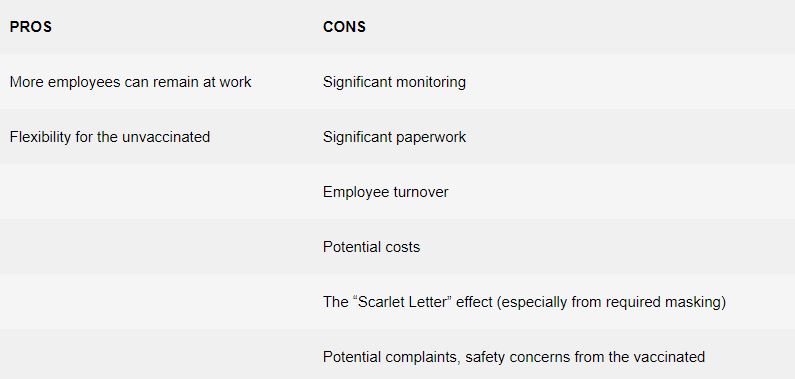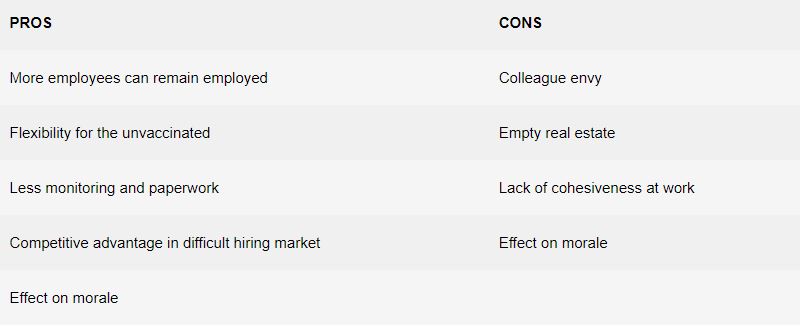OSHA’s recently issued Emergency Temporary Standard (ETS) on mandating vaccines has caused headaches for many employers and rankled others.
A flurry of lawsuits have been filed, and the Fifth Circuit has temporarily stayed the rule from taking effect. As we recently wrote about, confusion abounds as the ETS awaits judicial review by one lucky federal circuit court and perhaps, ultimately, the U.S. Supreme Court. OSHA itself has announced that it has “suspended activities related to the implementation and enforcement of the ETS pending future developments in the litigation.”
While we wait to see whether the ETS will be upheld, the January 4, 2022, deadline for compliance is around the corner … just past the holidays. As a best practice, employers with 100 employees or more should (continue to) prepare for the ETS to go into effect, or they risk being unable to do so in time (and thus subject to fines).
When planning the implementation of the ETS, employers face two overarching choices:
To Test or Not to Test?
Employers that do not wish to establish, implement and enforce a written mandatory vaccination policy have another option: the ETS provides that an employer may establish, implement and enforce “a written policy allowing any employee … [to] provide proof of regular testing for COVID-19 … and wear a face covering ...”
The ETS does not require employers to pay for testing, but state and local laws may. Additionally, the testing/masking option under the ETS requires considerable efforts on the part of employers. First, employers must ensure employees test at least once per week and wear a mask at all times in the office (except when “alone in a room with floor to ceiling walls and a closed door”). Second, employers must collect proof of each test result and retain the records (as confidential medical records) for so long as the ETS remains in effect. Third, employers must remove employees who fail to provide proof of their COVID-19 test (each week) until they provide such proof.
What an employer chooses to do will come down to the business realities it faces:
- Are its employees vaccinated already?
- Is it facing a worker shortage?
- Will employees quit if they are required to be vaccinated?
- Will the company be able to support the requirements of monitoring and collecting information from the unvaccinated?
- Additionally, how will the decision affect morale?
- Will employees forced to wear masks in the office feel shunned by vaccinated coworkers?
These are all issues employers must grapple with in the coming months. Here are some advantages and disadvantages of testing employers in lieu of a mandate:

Remote Work … A Rule or an Exception?
Employers who may cringe at a mandatory vaccination policy may feel equally bad about weekly testing. Especially if the workforce is vehemently against both. There is, of course, one additional option: remote employment.
The ETS’s FAQs state that employees who “do not report to a workplace where other individuals such as coworkers or customers are present or while working from home” do not need to vaccinate or submit to weekly testing.
This might be a viable option for some companies. In 2019, remote employment might have been a non-starter for many, if not most, employers. However, the pandemic has shifted many businesses to hybrid and work-from-home models. While this is not an option for many employees, some can and have been working successfully from home full-time.
However, many employers are eager to welcome employees back to the office for a variety of reasons, not least of which is to facilitate collegiality and reduce the high levels of turnover the country is currently experiencing.
As for employees, some relish working from home, while others are excited to return to the office. The decision to permit or prohibit remote work will inevitably rub some employees the wrong way. Following are some of the advantages and disadvantages of moving unvaccinated employees to remote working:

If you would like more information or would like to discuss these issues further, please contact a member of Gould & Ratner’s Human Resources and Employment Practice or visit our Coronavirus/COVID-19 Resources page.



